

|
by Joseph Brennan. Copyright 2001, 2002. |
9 Ave lower levelPassenger service: June 1916 - May 1975.Existing abandoned portions: 2 platforms, 3 trackways (one with track). Touring: W M trains to 9 Ave. The open station is outside in open cut. To glimpse the closed lower level, look down stairways from the station platform, and look into the track approaches from train windows north of the station. construction and operation9 Ave station is part of the Dual System project of 1913. From the extensive track junctions north of the station, branched off the new 4 Ave subway and the old 5 Ave El to reach two elevated lines with separate stations at 9 Ave. The upper level hosts the New Utrecht Ave line, commonly called the West End line, and the lower level formerly hosted the Gravesend Ave line, commonly called the Culver line. Before 1916, the 5 Ave El had operated service into ground level Culver and West End lines that ran from the edge of nineteenth century Brooklyn to Coney Island. Both were originally shortline steam railroads running in private right of way mostly along public highways, and had been acquired by the BRT system and converted to electric trolley operation. From 1895 and 1900 respectively, the Culver and West End lines saw a summer-only service from the 5 Ave El to Coney Island. The el trains shared the tracks with trolley cars. Because of increasing housing development along the lines, starting in March 1907, both routes were converted to all-year el service. The trains, operating off trolley wire, faced a grade crossing every block and loaded from rail-level platforms. The situation led to the Dual System plan to build elevated versions of almost the same routes. Once the elevated Culver and West End lines opened, trolleys returned to the surface lines for a few decades longer. The right of way in which 9 Ave station is built was that of the South Brooklyn Railroad, a steam railroad built to mainline standards with terminal and dock facilities. Some West End and Culver trains ran via the South Brooklyn to boat connections for Manhattan, at various dates from 1892 onward. The original route was an open cut for two tracks. Details are lacking but the thousand-foot brick arch tunnel from about 5 Ave to 6 Ave is either original or was built in 1902 to close part of the cut. It was extended another hundred feet east in 1905. Alongside the South Brooklyn cut was separate property used by the West End and Culver lines themselves. The 5 Ave El route came down a ramp built in 1895 at 37 St, into the property around the Union Depot established in 1890 by the Brooklyn, Bath and West End Railroad and Prospect Park and Coney Island Railroad, just north of the South Brooklyn cut. It is still transit property today, occupied by a bus garage and a rail materials yard. East of the South Brooklyn's tunnel, the surface route crossed over to the south side of the cut. Both the cut and and surface routes had junctions at 9 Ave from which tracks led to the Culver line, almost straight ahead, and the West End line, which ran along the east side of New Utrecht Ave. The Dual System routing appropriated the South Brooklyn line by agreement with the BRT system. A junction with the subway was built at 4 Ave, in open cut, from which subway trains entered the old tunnel and then into a huge widened cut. 5 Ave El trains were re-routed into the same cut. At 9 Ave, a two-level station was built, with the West End line on the upper level because it goes into an elevated viaduct just beyond the station. The Culver line on the lower level comes up into the Culver right of way and then ran from there to its own elevated structure. For one reason or other, the BRT paired the 4 Ave subway with the West End line, and the 5 Ave El with the Culver. So at 9 Ave, the subway station is over the el station, and the el trains are in a subway station, even though the tunnel is barely longer than the station itself. 9 Ave station opened in June 1916, when the new West End line opened. The new Culver line did not open until March 1919, so for almost three years, 5 Ave El trains ran off the el, through the modern junction and underground station, and then into the old surface level railroad, past the ramp being built to the new elevated Culver line. Culver train service has a fairly complex history. Up to 1931, 5 Ave El trains provided all the service, and 9 Ave must have been busy with Culver passengers changing to the West End subway trains for a faster ride and access to many more places. The wooden el trains were slow and ran no farther than the end of the Brooklyn Bridge at Park Row, Manhattan. When the Nassau St loop in lower Manhattan finally opened in 1931, the BMT began operating a mixture of subway and el services to the Culver line. Subway service ran Monday to Saturday, to Kings Highway in rush hours and summer Saturdays, and to Coney Island midday and other Saturdays. El service went to Coney Island rush hours, nights, summer Saturdays, and all Sundays, and otherwise ended at 9 Ave station. Is that clear? The BMT didn't have enough subway cars for full service, so at rush hours and summers, the el had to pick up the service to the end of the line, so the subway trains could shortline. 9 Ave lower level saw its peak train service in these years, with both el and subway trains, and el trains reversing in the middle track during some hours. The 5 Ave El was one of the many that closed in 1940 when the City bought the IRT and BMT systems. The subway had to handle all Culver service, except that because of the car shortage, a few el trains still handled service beyond Kings Highway in rush hours. Culver trains never ran to Broadway, but always ran either via Nassau St to end at Chambers St, or in rush hours around the loop, bridge to tunnel. The Transit Authority fulfilled a longstanding Board of Transportation plan in October 1954 when the IND subway was connected to the Culver line at Ditmas Ave station and took over all service to Culver stations beyond that point. BMT Culver service from a single track terminal at Ditmas Ave continued as before on weekdays, but nights and weekends it was a shuttle to 36 St. Ridership dropped, and in May 1959, it was made a shuttle full time, between Ditmas Ave and 9 Ave only. The Culver shuttle was a rail fan route by the late 1960's. It was one of the last places to find the old BMT standard subway cars, which ran it almost to the end. The dark, deteriorating lower level at 9 Ave, and the partly dismantled elevated line gave it a mood of decay. There was just one track, the center at 9 Ave and the west side on the el, and one train operated all the service. The end was obviously in sight, but it somehow hung on until 1975. Passenger use was light. For a time after abandonment, passengers were allowed a free transfer to the parallel 39 St bus line, as a replacement. |
diagram |
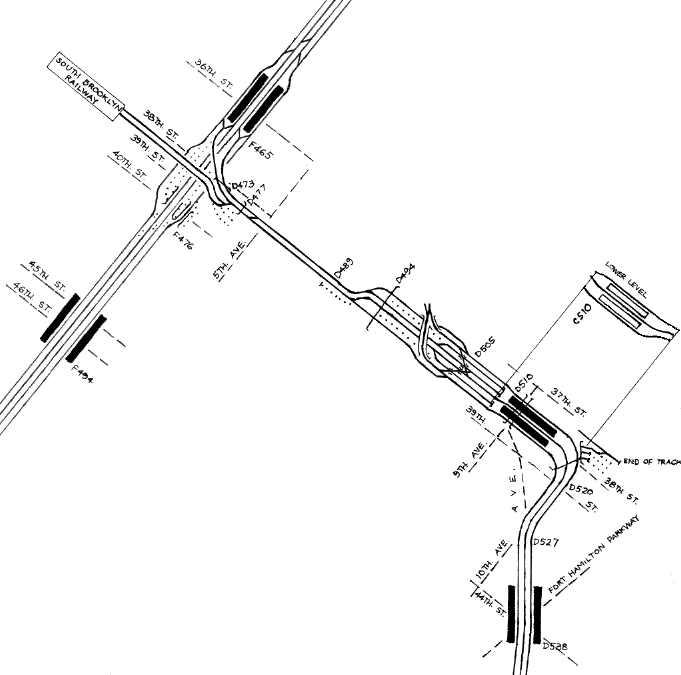
|
The Culver and West End trains branched off the 4 Ave subway via the ramp south of 36 St station at F465. The route comes out into the South Brooklyn open cut at D473, and then almost at once enters the old tunnel from D477 to D489. A tunnel extension done for the Dual System in 1914-1915 continues into the wide open cut at D494. The 5 Ave El trains came in via the ramps still in place north of D505, which are in use now for access to the Transit Authority materials yard (not shown). Here the Culver tracks separate from the West End. At C510 is 9 Ave lower level (D510 and the rest of route D is the West End line). At the present time a single non-passenger track passes through the lower level and out to meet a track from the yard east of the station. Shown as three dotted lines is where the line once continued to the elevated Culver line. A curiosity back on 4 Ave is the large unused junction at 40 St. When the subway was planned as part of the Triborough System, use of the BRT's South Brooklyn cut was not anticipated, and instead a four-track subway was to be built in 40 St to reach the equivalent of the Culver and West End lines. The junction is complete to the east side of 4 Ave, ironically the only junction of two four-track lines in the system. It can be seen best from the front end window of southbound N or R locals out of 36 St. |
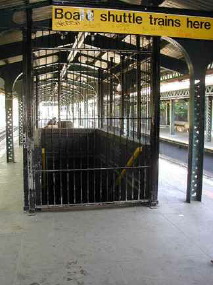
Stairways on the open upper level of 9 Ave station allow a very limited view of the closed lower level. The sign about boarding shuttle trains does not refer to the Culver Shuttle, but the West End shuttles to 36 St that run at night. You don't see much looking down the stairway (below). Photo at left copyright 2001 by Kevin Walsh. From Reliquaries of the Rails at his web site Forgotten NY. |
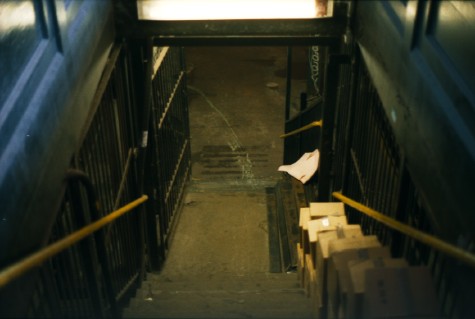
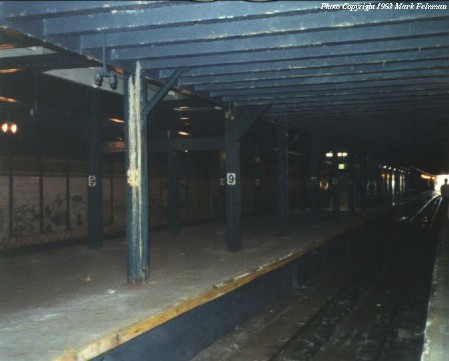
|
Mark Feinman snapped a good general view of the lower level during a Transit Museum tour. Copyright 1993 by Mark Feinman. From the Ninth Ave Lower Level page at the New York Subway Resources site. |
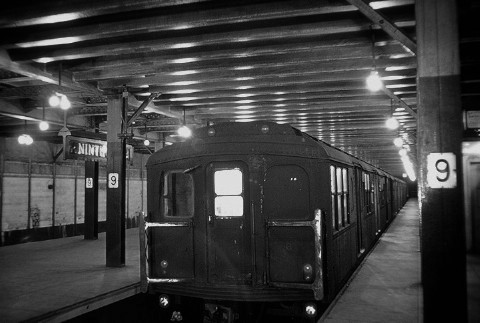
|
Doug Grotjahn's photo from 1968 shows the Culver shuttle train in its usual position in the center track. Doug Grotjahn, Joe Testagrose collection. From the Ninth Ave Lower Level page at the New York Subway Resources site. |
|
|
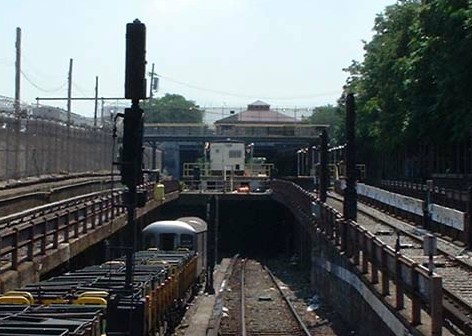
|
The portals of the tunnel are just outside the station. Above, at the west (or north) portal, a work train enters the center track of the lower level. The platforms of the upper level are just visible straight ahead, and over them the bridge carrying 9 Ave and the station house over all. Below, at the east portal, the West End line has just left the elevated (off frame to the left) and curves in over the remains of the Culver line as it enters the tunnel. Photo above copyright 2001 by Harry Beck. From the West End line page at http://www.nycrail.com. |
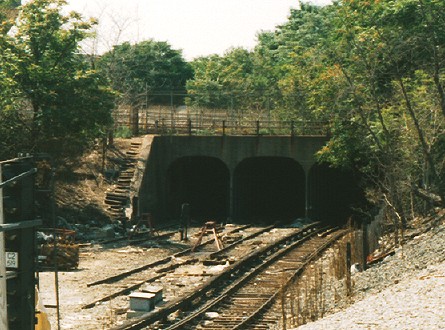
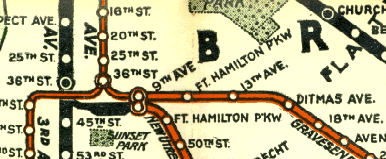
The official BMT map of 1924 shows subway and elevated lines in black and red respectively. Although the 9 Ave station is shown as two stations, things are otherwise a bit simplified in order to show clearly that the Culver and West End services come alongside but do not interconnect. |
|
Scan by Joe Korman. For the full map, see http://www.nycsubway.org/maps/historical at the New York Subway Resources site. |
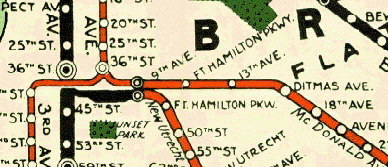
The 1939 BMT map is a too-slavish copy of the older map, and fails to show that the subway now operates into the Culver line about as much as the el does. They still look like separate services. Gravesend Ave had been renamed McDonald Ave. |
|
Scan by Joe Korman. For the full map, see http://www.nycsubway.org/maps/historical at the New York Subway Resources site. |
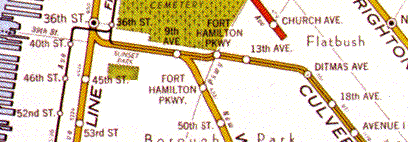
The Hagstrom subway map designed in 1936 shows 9 Ave as a single station, with the thin black line for elevated service curving into the subway line at 5 Ave and running out the Culver line. The Culver line had had joint subway and el service for five years. From a reproduction found in Twelve Historical New York City Street and Transit Maps, H & M Productions, 1997. |
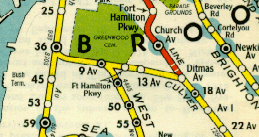
The official Board of Transportation map for 1948 was of course the Hagstrom subway map. This is the smaller version. The Culver had only el service at this time. The map shows local and express stops on the Culver line. The IND subway extension to Ditmas Ave is optimistically shown as a red dashed line, but it did not open for another six years. |
|
Scan by Joe Korman. For the full map, see http://www.nycsubway.org/maps/historical at the New York Subway Resources site. |
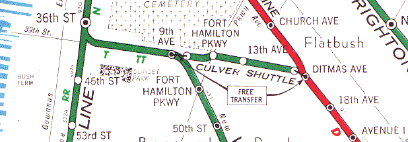
Hagstrom had started showing 9 Ave as two station circles once the Culver line was only a shuttle. This is a 1965 edition of the larger size map, the same base map as the 1936 first edition shown above. Around this time, the BMT was changed from yellow to green, either to permit showing the route letters in the line color, as they had long done for the red IND lines, or to match the Transit Authority diagram green, or both. The number of colors printed was also reduced, for a somewhat uglier map. |
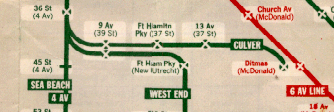
The Transit Authority diagram for 1959 still showed the Culver line as running through to the subway. 9 Ave is shown as two stations. The white rectangle around the name and the two stations indicates the free transfer, as it does also at Ditmas Ave. The express station symbol is used because the Culver ran express in rush hours. Artistic license has the Culver and West End separate all the way to the 4 Ave subway. Less elegant is the depiction of the Culver's Fort Hamilton Parkway station as adjacent to the West End line, but it was close. |
|
Scan by Joe Korman. For the full map, see http://www.nycsubway.org/maps/historical at the New York Subway Resources site. |
|
Later Transit Authority diagrams showed the Culver shuttle as in this 1964 edition. A distinction was being made here where interdivisional free transfers are highlighted in yellow, something only the authority's bookkeepers worried about. |
|
|

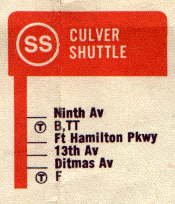 The new Transit Authority diagram of 1967 showed each train route in a separate color, but stations connected by free transfer were shown by a single box listing the available trains. 9 Ave therefore is a single box with the West End services B TT and the SS that was used for all shuttles starting in 1967. On the back of the map, the strip map listed the orange SS Culver Shuttle. The New Utrecht Ave part of the West End was here shown as diagonal instead of vertical, which pushed 9 Ave closer to the 4 Ave subway and made the shuttle look longer. |
|
|

|
The revised 1969 map showed all shuttles in green. |

The 1974 map by Massimo Vignelli was the most stylized official map. In this design, 9 Ave was portrayed as very close to 4 Ave, although it is really almost halfway to Ditmas Ave. Station dots shown near each other were to be understood as free transfers. The Culver shuttle green line continues past its terminals. This was the last map to show the Culver shuttle, since it closed in 1975. |
|
A 1928 Red Book guide to Brooklyn listed the 5 Ave El service to the Culver line. The 5 Ave El to Bay Ridge is listed as from Sands St at the Brooklyn end of the Brooklyn Bridge, and the Culver service evidently took 8 minutes longer running from Park Row at the Manhattan end. |
|
A 1939 Geographia Complete Street Guide listed the subway and elevated service to the Culver line. This is greatly simplified from the actual service. |
|
|

|
|
|
|
|